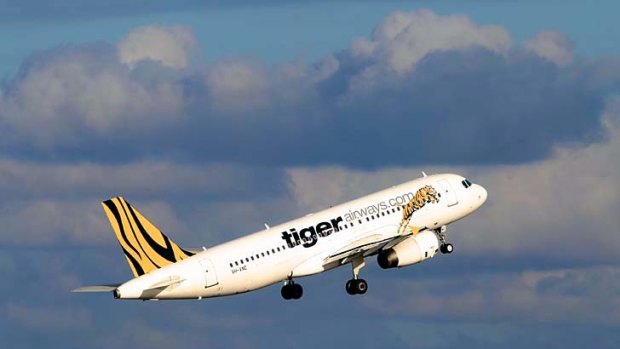
It will take some time before Tiger Airways can really determine whether it has a future in the Australian market.Credit: Dallas Kilponen
It is likely to take until the end of this year before Tiger Airways can assess whether it has a viable Australian consumer market and a future in its southern outpost.
The Singapore-based carrier did massive damage to its brand – and even some minor collateral damage to the brand of its biggest shareholder, Singapore Airlines – when it was grounded from July 1 to August 12 for safety violations.
However, it is still difficult for the airline’s Australian consumer supporters to put their money where their mouth is as Tiger is taking an ultra-conservative approach to restarting services.
The airline is limited to just nine return services a day by the Civil Aviation Authority until the end of this month, compared with around 30 return flights a day in June before it was grounded.
From tomorrow, there will be five Sydney-Melbourne return services and two morning and night between Melbourne and Brisbane – all with extra minutes added to the scheduled flying time as part of the airline’s resolve to start fixing its terrible reliability problem.
Up until the end of June, Tiger had by far the highest percentage of flights in Australia running late and a high percentage of cancelled flights which, at one stage this year, reached more than six per cent - close to a record anywhere in the world.
Between Sydney and Melbourne, you’ll now notice Tiger’s scheduled flying time is 95 minutes in both directions – more than even the most on-time airline, Qantas, which now calls it 85 minutes northbound and 95 minutes southbound.
(This trick is being used by all airlines to improve their punctuality: just doctor the stats. Remember when Australian Airlines and Ansett used to call it 70 minutes northbound and 75 minutes southbound? Aviation writer Ben Sandilands points out that, in the 1950s and 1960s, Vickers Viscount turboprops, at just over half the speed of today’s jets, were able to cover the distance in both directions in a scheduled hour-and-a-half, such is the mess of airways management the Melbourne-Sydney route has become.)
I rode from Sydney to Melbourne and back on Tiger’s first flights since the grounding on August 12 and, apart from being stress-free and way ahead of time, it was an odd experience indeed.
The first oddity was that both flights were less than half full, which is unheard of an any airline these, but it’s not hard to understand why: It takes up to two months for a modern computer reservations system to fill an aeroplane to today’s 80 per cent passenger load average, from the early bookers to the last-minute business travel fares.
Needless to say, Tiger has attracted very few last-minute fares in the past year or two because budget business travellers – those likely to pay a little or a lot more – were put off by the airline’s lack of reliability.
When the first Tiger flight left Tullamarine for Mascot on August 12, bookings had been open for less than 24 hours.
The second oddity was the cabin crew’s safety demonstration prior to takeoff. For inexplicable reasons, it was dramatic and you could have heard a pin drop. Absolute rapt silence.
The third oddity was that when the flight landed in Sydney, applause broke out, as in countries where flight is still a rare privilege. I think that was because many on board were among the true believers who understand the cost to Australian consumers if the third force in the Australian airline industry – the only competitor for the Qantas group and the Virgin Australia group — disappears.
The old saying is that it takes two to tango. But in the airline game, two is a price-fixing duopoly. It takes at least three to tango and the more the merrier.
Do you support the need for a third domestic airline? Do you support the doubters who have used the Tiger grounding to advance their case? Did you notice that fares rose after the Tiger grounding? Would you use the Tiger option in the future?
Sign up for the Traveller Deals newsletter
Get exclusive travel deals delivered straight to your inbox. Sign up now.